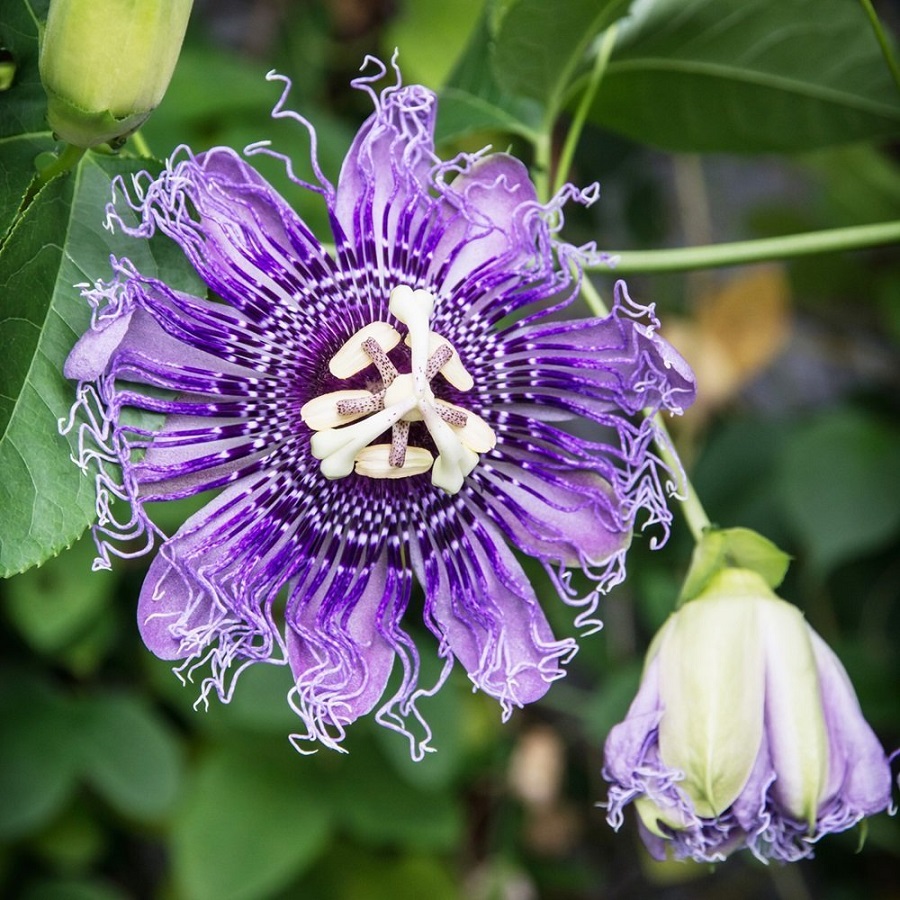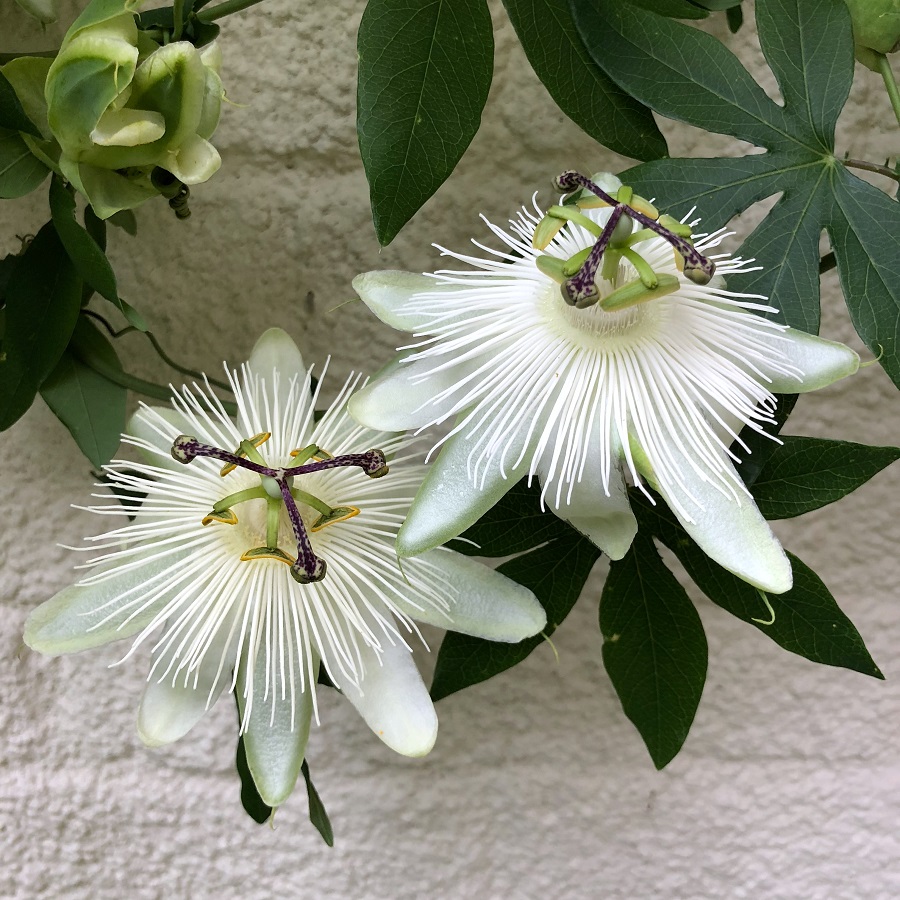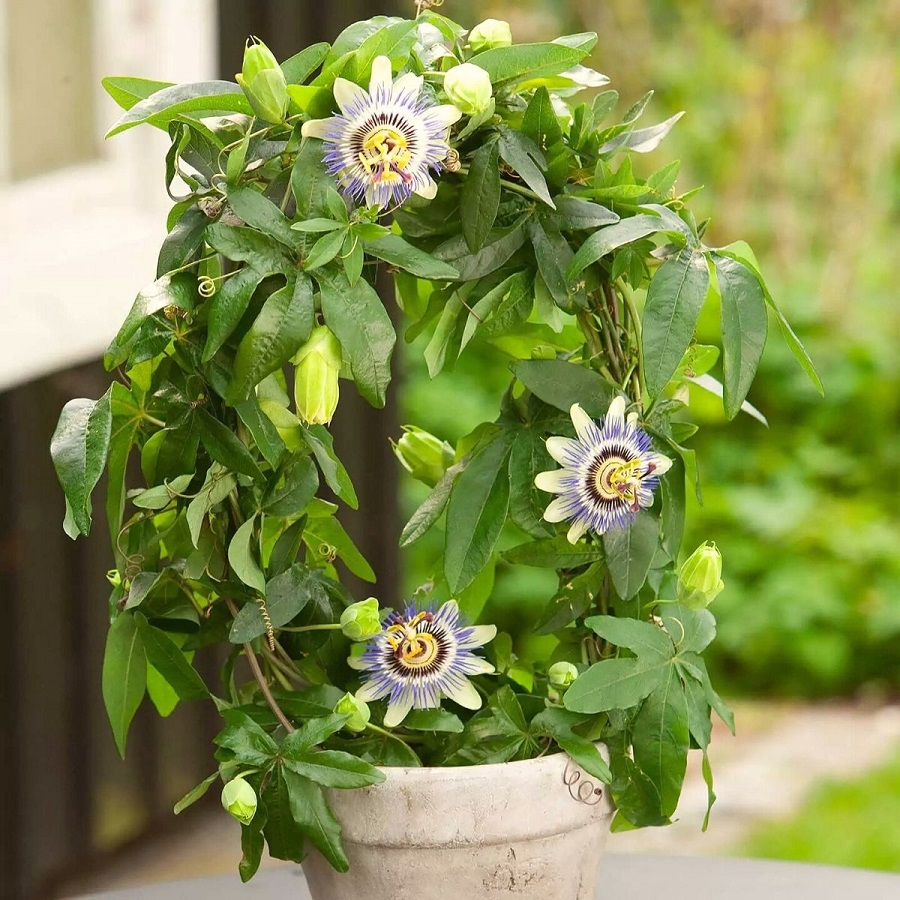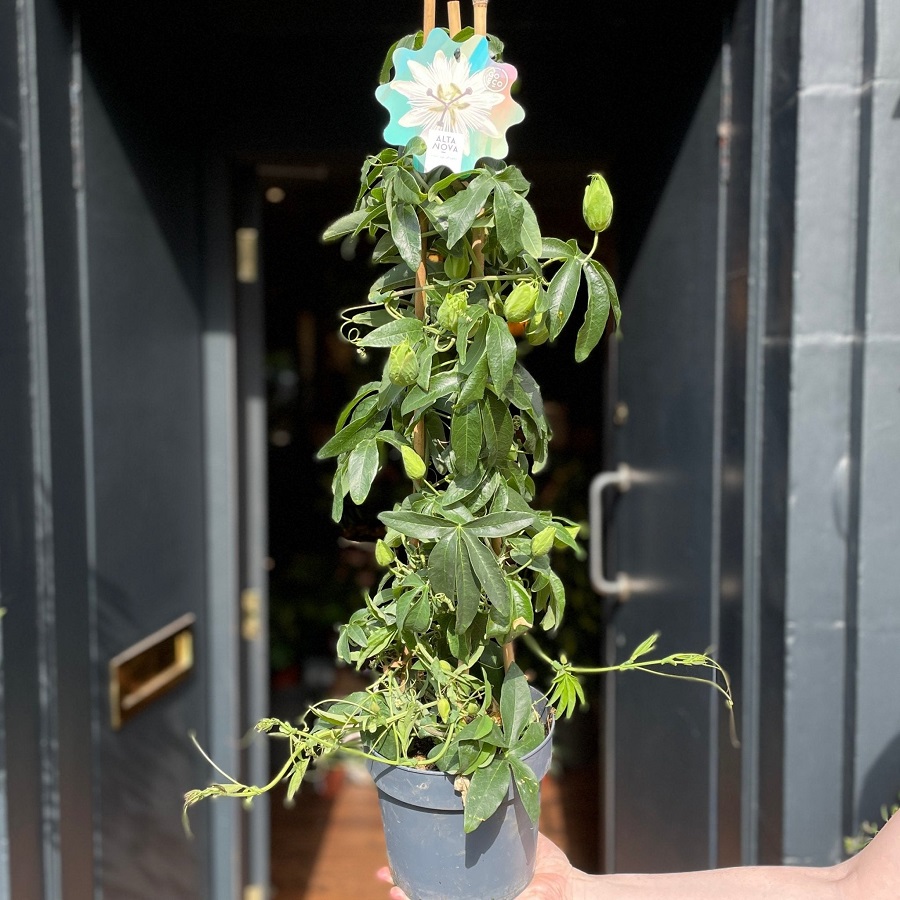Introduction to Passion Flowers
Passion flowers, with their intricate blooms, captivate gardeners worldwide. Originating from South America, these vigorous climbers are loved not only for their striking flowers but also for the delicious passion fruit some species produce. In colder climates, growing passion flowers in pots is a smart option. This allows for easy movement indoors to protect them from harsh winters. Through this guide, we will explore the steps and care necessary for nurturing passion flowers in containers. From selecting the right pot to winter care, you’ll learn all about cultivating these fascinating plants at home.
Selecting the Right Container for Passion Flowers
Selecting the correct container is crucial for growing passion flowers successfully. Begin with a large pot, as passion flowers are robust climbers that require ample space for root development. Look for a container at least 18 inches in diameter; this will provide a stable foundation for the growing vine. Ensure the pot is made from sturdy materials, such as thick plastic, terracotta, or wood, to support the plant’s substantial growth.
It’s essential to consider drainage when choosing your container. Opt for pots with several drainage holes to prevent waterlogging, which can be detrimental to the plant’s roots. Waterlogged soil can lead to root rot, a condition difficult to reverse and often fatal to passion flowers.
Additionally, think about the weight of the pot. A heavy terracotta pot is less likely to tip over but may be hard to move. If you plan to bring the passion flower indoors during cold months, a lightweight pot with a saucer might be more practical. However, avoid overly light pots that could tip or blow over outdoors.
Remember to account for the support structure in your selection. As passion flowers are climbers, the pot must accommodate a trellis or other support system. Choose a container that’s wide enough to insert a trellis comfortably or has a rim or handles where you can attach one. This will ensure your passion flower has the necessary support to thrive and showcase its beauty.

Ideal Soil Composition for Potted Passion Flowers
The ideal soil mix for passion flowers in containers combines good drainage with rich nutrients. Start with a high-quality potting mix that ensures both aeration and moisture retention. You can create a custom blend by mixing two parts potting soil, one part perlite or coarse sand, and one part compost or well-rotted manure.
Choosing the right soil mix is vital for the health of your passion flower. The mix should not compact over time, as this can suffocate roots and hinder water drainage. Organic material, like compost, adds essential nutrients and improves the soil structure, promoting healthy root growth. Perlite or coarse sand helps to loosen the mix, allowing water to pass through quickly and preventing root rot.
When filling your container, leave a gap of about an inch from the rim to accommodate watering and prevent spillage. Before planting, water the soil mix thoroughly, allowing excess water to drain. This step ensures the mix is evenly moist and ready for your passion flower vine.
Regularly check the soil’s moisture level with your finger. If the top inch feels dry, it’s time to water. Avoid over-watering, which can cause the roots to rot. With the proper soil composition, your potted passion flowers will flourish, offering vibrant blooms and possibly even fruit.
Supporting Climbing Passion Flowers in Pots
Support structures are essential for the healthy growth of climbing passion flowers in pots. To encourage sturdy growth and display the plant’s stunning blooms, use one of the following methods:
- Trellises: Install a trellis in the pot for the passion flower to climb on. Choose a height suitable for your space and sturdy enough to support the vine’s weight.
- Stakes: If space is limited, tall stakes can work as a central support. Secure the passion flower vine to the stake with soft ties to prevent damage.
- Fencing: If placed near a fence, passion flowers can use this as a support structure. Ensure the pot is close enough for the tendrils to reach.
- Support Wires: Set up horizontal wires across a wall for a simple support. The passion flower tendrils can twine round the wires.
Whichever option you choose, be sure the support is firmly in place before the plant grows too large. Regularly guide new growth onto the support, gently wrapping tendrils around the structure.
Remember, a well-supported passion flower will be healthier, grow better, and produce more spectacular blooms. Keeping vines organized also makes it easier to move the pot if needed, especially during the transition to winter care.
Watering and Drainage Essentials
Proper watering is key for potted passion flowers to thrive. Ensure consistent moisture but avoid sodden soil to prevent root issues.
- Consistent Moisture: Check soil weekly; water when top inch feels dry.
- Prevent Overwatering: Use containers with sufficient drainage holes. Excess water must escape easily.
- Drainage Layer: Add a layer of gravel or broken pottery at the pot’s base. This improves water flow.
- Monitor Weather: Reduce watering during rainy periods and increase during dry spells.
- Watering Method: Soak the soil until water runs from drainage holes for deep hydration.
- Avoid Water Stress: Don’t let the soil dry out completely; it stresses the plant.
Balancing water and air around roots is crucial. With good practices, your passion flowers will flourish.

Lighting and Temperature Requirements
When growing passion flower in pots, providing the right amount of light and maintaining suitable temperatures are essential for plant health and bloom production. Here’s what you need to know to optimize these conditions for your passion flowers:
- Ample Sunlight: Passion flowers require full sun to partial shade to flourish. Aim for about 6 to 8 hours of sunlight daily, preferably morning sun which is gentler and can reduce the risk of leaf burn in hotter climates.
- Ideal Temperatures: These tropical plants thrive in temperatures between 65°F and 85°F (18°C – 29°C). They can survive minor dips in temperature but should be protected from frost.
- Heat Tolerance: In regions with intense heat, providing afternoon shade can help prevent overheating and stress on the plant.
- Transition to Indoors: Before the first frost, transition your passion flower indoors if you live in a cooler zone. Choose a spot with ample light and minimal temperature fluctuation.
- Winter Sunlight: If overwintering indoors, ensure the plant receives sufficient light. South-facing windows work well, or consider grow lights for darker areas.
By managing the lighting and temperature conditions, your potted passion flowers will have the best chance to grow vigorously and produce their stunning blooms.
Fertilization and Nutrient Management
To keep your potted passion flowers healthy and blooming, it’s important to feed them properly. Here are some tips for fertilization and nutrient management:
- Regular Fertilization: Feed your passion flowers with a balanced, water-soluble fertilizer every two weeks during the growing season. Look for a formula suitable for flowering plants.
- Controlled-Release Fertilizers: These can be a convenient option as they slowly release nutrients over time. Apply these at the start of the growing season.
- Organic Options: Compost or organic fertilizers can provide nutrients while improving soil health. Apply compost to the soil surface annually.
- Adjust for Growth Stages: Younger plants need more nitrogen for leaf growth, while flowering plants benefit from higher phosphorus levels.
- Over-Fertilization Dangers: Too much fertilizer can damage roots and reduce flowering. Always follow product directions and avoid excess.
- Trace Minerals: Sometimes, potted plants need extra minerals like magnesium or iron. Use a specific nutrient supplement if leaves show deficiency signs.
Proper fertilization supports vibrant growth and abundant blooms. However, remember to avoid over-feeding, which can harm your passion flowers.
Pruning and Winter Care for Container-Grown Passion Flowers
Pruning is key to keeping passion flowers healthy. After flowering, prune to maintain shape and prompt next season’s growth. Cut back overgrown tendrils and remove dead or weak growth. In mild climates, a light trim may suffice. But in colder zones, reduce the vine to a manageable size for indoor overwintering.
Winter care for potted passion flowers involves protection from freezing temperatures. Before the first frost, move your potted vine indoors. Choose a cool, well-lit room, such as a sunroom or a spot near a sunny window. Reduce watering in winter but do not let the soil completely dry out. Keep an eye on indoor heating sources; they can dry the air and stress the plant.
Monitor the vine for pests or disease during winter months. Inspect leaves regularly and treat any infestations immediately. With proper pruning and winter care, container-grown passion flowers can survive the cold season to thrive again in spring.

Propagation of Passion Flowers in Pots
Propagating passion flowers can be rewarding and allows you to expand your collection or share with friends. Here’s how to propagate passion flowers in pots efficiently:
Use Cuttings: Spring is the best time to take cuttings. Look for healthy, non-flowering shoots. Cuttings should be about 6 inches long with several leaves. Remove the leaves from the bottom half of the cuttings. This ensures that the energy goes into root development.
Rooting Medium: Use a well-draining mix, containing perlite and peat moss, to plant your cuttings. The medium should be moist but not waterlogged. Insert the cut cuttings into the mix.
Rooting Hormone: Though optional, dipping cuttings in rooting hormone can encourage root growth. This step increases the success rate of propagation.
Create Humidity: Cover the cuttings and pot with a clear plastic bag or place them in a mini greenhouse. This creates a humid environment, similar to a propagator, which promotes root development.
Patience is Key: Roots take several weeks to develop. During this time, keep the soil moist and place the pot in a warm, bright area, avoiding direct sunlight. Watch for new growth as a sign of successful rooting.
Once rooted, transplant each new passion flower plant into its own pot with the ideal potting mix discussed earlier. Provide similar care as established plants.
By following these steps, you can successfully propagate passion flowers in pots, resulting in more beautiful vines to enhance your garden or home.
Protecting Potted Passion Flowers from Pests and Diseases
Proper care can shield your potted passion flowers from pests and diseases. Here’s how to protect them:
- Regular Inspections: Examine your plants often for early signs of trouble. Spots, holes, or discoloration on leaves can signal pests or disease.
- Pest Control: If you spot pests, remove them by hand or use insecticidal soap. Avoid harsh chemicals that can harm the flowers and beneficial insects.
- Disease Prevention: Ensure good air circulation around the plant. Cramped spaces can invite fungal infections like mildew.
- Clean Tools: Disinfect pruning shears and other tools. This prevents spreading disease from one plant to another.
- Healthy Soil: Refresh the potting mix annually or as needed. This minimizes disease-causing pathogens in the soil.
- Isolate New Plants: Quarantine new passion flower plants before adding them to your garden. This helps stop the spread of pests and diseases.
- Optimal Watering: Water at the base to avoid wetting the leaves. Too much moisture on leaves can lead to fungal diseases.
By following these practices, you can enjoy healthy, thriving passion flowers in your pots for many seasons.
